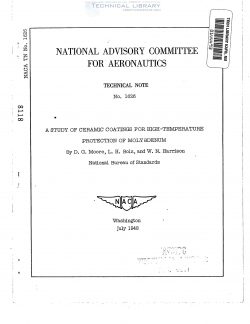naca-tn-1626
- Version
- 82 Downloads
- 1.37 MB File Size
- 1 File Count
- December 4, 2016 Create Date
- December 4, 2016 Last Updated
National Advisory Committee for Aeronautics, Technical Notes - A Study of Ceramic Coating for High Temperature Protection of Molybdenum

The high melting point (#7500 F) and comparatively large potential
supply of molybdenum suggest that this metal may be useful at tempera-
tures above the melting points of most metals and alloys. In order to
use it‘at high temperatures in the presence of oxygen, however, the
molybdenum must be protected against oxidation, and hence it is logical
to apply a protective ceramic coating. Several such coatings were
developed and applied in the form of water suspensions or "slips" to
specimens of molybdenum, by dipping or spraying, after which the
pieces were dried and fired at a temperature of 21500 F in oxygen-
free atmospheres. Tests of the coated pieces included (1) heating
in a gas-oxy n flame, (2) heating at constant temperature in an air
atmosphere, ?3) thermal-shock tests, and (h) service testing of
parts that were finished with a selected ceramic coating in the
blast of ram-Jet engines.
The results of these various tests indicated that the oxidation
of the molybdenum was greatly retarded by the best of the ceramic
coatings tried. In an air atmosphere at 16500 F, unprotected
0.0hO-inch molybdenum sheet was found to decrease to one-half of its
original thickness in 1/2 hour- There was no decrease for ceramic
coated molybdenum heated for 70 hours under the same conditions.
At a gas temperature approximating 35000 F, giving a surface
temperature on the specimen of 26000 F or more, only short-time
protection of the molybdenum was attained. The oxidation rate at
these high temperatures was found, however, to be sufficiently
retarded by the presence of the ceramic coating to make the use of
coated molybdenum feasible for special high-temperature applications
in which prolonged service is not required-
One current use of these ceramic coatings is to protect
molybdenum pitot tubes which are built into the nozzle end of ram-
Jet engines of a type used for pilotless aircraft. ‘ These tubes,
which aresubjected to a gas temperature of about 30000 F, are
expendable and need not last over 5 minutes. Test of a coated tube
under simulated service conditions indicated a life in excess of
#5 minutes.
| File | Action |
|---|---|
| naca-tn-1626 A Study of Ceramic Coating for High Temperature Protection of Molybdenum.pdf | Download |

Comment On This Post